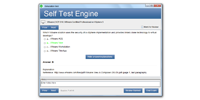ダウンロード可能なインタラクティブApigee-API-Engineerテストエンジン
Apigee Certification Programの基礎準備資料問題集には、Apigee Certification Program Apigee-API-Engineer試験を受けるために必要なすべての材料が含まれています。詳細は、正確で論理的なものを作成するために業界の経験を常に使用しているApigee Certification Program によって研究と構成されています。
JPNTestでGoogle Apigee-API-Engineer問題集をチョイスする理由
JPNTestは、1週間で完璧に認定試験を準備することができる、忙しい受験者に最適な問題集を提供しております。 Apigee-API-Engineerの問題集は、Googleの専門家チームがベンダーの推奨する授業要綱を深く分析して作成されました。弊社のApigee-API-Engineer学習材料を一回のみ使用するだけで、Google認証試験に合格することができます。
Apigee-API-EngineerはGoogleの重要な認証であり、あなたの専門スキルを試す認定でもあります。受験者は、試験を通じて自分の能力を証明したいと考えています。 JPNTest Google Cloud - Apigee Certified API Engineer は、Apigee Certification Programの128の問題と回答を収集して作成しました。Google Cloud - Apigee Certified API Engineerの知識ポイントをカバーし、候補者の能力を強化するように設計されています。 JPNTest Apigee-API-Engineer受験問題集を使用すると、Google Cloud - Apigee Certified API Engineerに簡単に合格し、Google認定を取得して、Googleとしてのキャリアをさらに歩むことができます。
あなたのApigee-API-Engineer試験合格を100%保証
JPNTestテスト問題集を初めて使用したときにApigee Certification Program Apigee-API-Engineer試験(Google Cloud - Apigee Certified API Engineer)に合格されなかった場合は、購入料金を全額ご返金いたします。
Apigee-API-Engineer試験の品質と価値
JPNTestのApigee Certification Program Apigee-API-Engineer模擬試験問題集は、認定された対象分野の専門家と公開された作成者のみを使用して、最高の技術精度標準に沿って作成されています。
Apigee-API-Engineerの迅速なアップデート対応
Apigee-API-Engineer試験に変更がございました場合は、現在の試験と一致するよう、瞬時に学習資料を更新することができます。弊社は、お客様に最高、最新のGoogle Apigee-API-Engineer問題集を提供することに専念しています。なお、ご購入いただいた製品は365日間無料でアップデートされます。
Google Cloud - Apigee Certified API Engineer 認定 Apigee-API-Engineer 試験問題:
1. Which policies can be used to create or modify a request message for a service callout? Select all that are correct
A) AssignMessage
B) ServiceCallout
C) RequestMessage
D) Message Validation
2. Which JavaScript statement can be used to raise a fault from a JavaScript policy named "Weather"?
A) contextsetVariablefWeather.Fauir, "true*);
B) return false;
C) return-1;
D) throw "Bad Data",
3. You are working on a project that adheres strictly to the Roy Fielding REST concepts. You need to update a single property named "status" of a complicated entity What should you do?
A) Fetch the full entity, update the status value locally. DELETE the original entity and POST the new version.
B) Create a new service that uses the PATCH verb designed to update only given fields. PATCH /api/trucks/42 HTTP/1.1 {status: 5}
C) Create a new service that uses the UPDATE verb that accepts the "status* property and updates the entity UPDATE /api/trucks/42/status HTTP/1.1 {status: 5}
D) Fetch the full entity. Change only the status value and then send the whole object in the request body of the PUT service
4. You are implementing Concurrent Rate Limit, Spike Arrest and Quota policies in your proxy You want to make sure the simplest checks run first Using the flow shown in the diagram, which order of operations should you follow?
A) Spike Arrest > Quota > Concurrent Rate Limit
B) Concurrent Rate Limit > Spike Arrest > Quota
C) Quota > Spike Arrest > Concurrent Rate Limit
D) Quota > Concurrent Rate Limit > Spike Arrest
5. Given the following Javascript code snippet, which statement is true?
var paloAlto = httpClient.get{'http://weather.yahooapis.com/forecastrss?w=2467861'); context.session['paloAlto'] = paloAlto;
A) The code execution will wait for the httpClient to receive a response and store that into a session vanable named paloAlto.
B) The httpClient request will send a POST request to http //weather yahooapis com/forecastrss
C) The string paloAlto' will be stored in a message flow variable named paloAlto
D) The code execution will complete even if the httpClient has not yet received a response
質問と回答:
| 質問 # 1 正解: A | 質問 # 2 正解: A | 質問 # 3 正解: A | 質問 # 4 正解: D | 質問 # 5 正解: C |


 397 お客様のコメント
397 お客様のコメント





